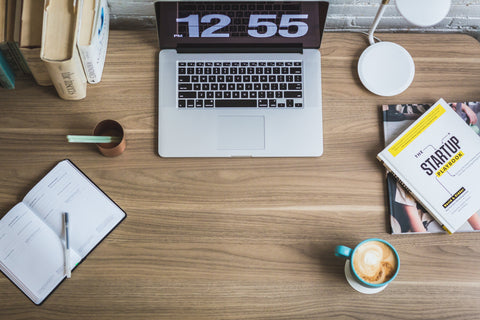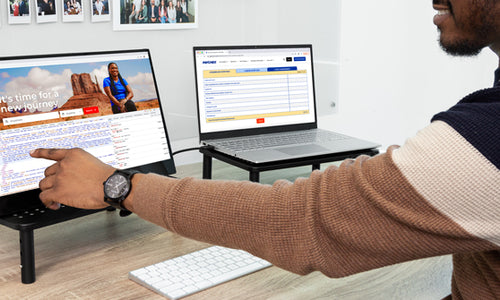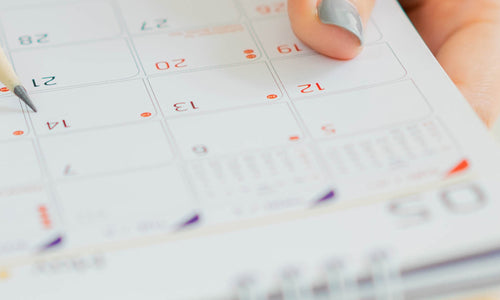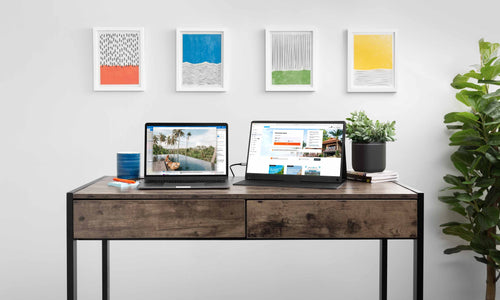19 Ways to be More Productive
Do you ever feel like your tasks keep pilling up and you need more time in a day to get everything done? You're not alone. Good news is we've found 19 ways to help you be more productive and get more done!
1. Declutter your work surface
The state of your physical space says a lot about your ability to handle stress and complete tasks. While a few little knick-knacks and mugs on your desk add a bit of personality, too much excess stuff will leave you feeling weighed down. Take a few minutes at the start of your workday to clean up your act. Toss or digitize stacks of paperwork, give your desk a good wipe down, and maybe even consider finding a new home for that novelty bobblehead that's been collecting dust since 2014. Just being able to have space to spread out and take visual inventory of your tasks will be sure to revolutionize your workflow.

2. Stop babysitting your inbox
We're all a little guilty of doing this. Keeping your email open at all times of the day, stopping in your tracks to respond to every message in real time. While that's certainly polite, nothing kills productivity quite like intermittent quick tasks. Instead of doing this, try batching emails into dedicated chunks of time, no more than 4-5 times a day. This way, responding to emails can be viewed as its own task, allowing more comprehensive, attentive responses. Plus, another thing to check off of your to-do list.
3. Use a second screen
If you're not already using a second monitor, you can't imagine the benefits of having one. In fact, my first day working my first "real job," I tried to politely decline a second screen. Thankfully my manager pushed back and insisted, and now I can't imagine life without one. A second screen allows you to keep reference material handy without wasting time switching back and forth between tabs. According to research done at the University of Utah, all that clicking back and forth adds up: Using a second monitor can save you 2.5 hours per day. Think about what you could do with all of that time!
4. Aim to have one major task done before lunch
Start your morning with a simple task to get the ball rolling, then tackle a larger to-do and try to have it done before lunch. This will allow you to really enjoy your break and offer a distinct timeframe to keep you on track. Then once you're refreshed from your meal, you can go into your afternoon with a clean slate.
5. Don't be afraid to go on "Do Not Disturb"
If you really need to focus and cut out chatter and other office distraction, don't be shy about going offline. Coworkers will understand; many internal communication systems have a "do not disturb" option for this exact purpose. Flip the switch, put your headphones in, and get it done.
6. Listen to ambient noise
Speaking of headphones, not everyone can listen to music while they work. For tasks that require critical thinking, songs with lyrics can be sensory overload. Spotify, YouTube, and other listening platforms have playlists full of instrumental music, movie scores, or just white noise that can filter out external stimuli without causing distractions of their own.

7. Pick an essential three
At the start of your day, realistically think about three essential goals that need to be done. Write them down and focus your energy on them, and be pleasantly surprised by how manageable your to-do list becomes.
8. Breaks tasks up into smaller parts
With the "essential three" in mind, think of tasks in less "macro" terms. Don't think of a huge project as a single thing to check off of your to-do list if deep down you know it's a multi-step process that'll take you a few days. Being unrealistic and overambitious with your goals and abilities has negative effects on self-esteem and longterm productivity, so don't psych yourself out!
9. Keep a backlog
The universe is full of missteps, but don't let that throw your productivity off its tracks. Sometimes your point of contact is out sick. Sometimes the internet goes down. But that doesn't mean you can just give up. Keep a digital or physical list of lower priority tasks that can be completed in the longterm or without a firm deadline. When you have hiccups that impede from your regular to-do list, you can fall back on this list to make sure you're still productive in spite of unplanned events. Even if it's something as simple as "organize filing cabinet."
10. Have an energizing lunch
When you enjoy your lunch break, choose something filling and nutritious. This way, you can get back to your to-do list without getting distracted by the urge to snack. Plus, when you're full (courtesy of a healthy meal), you're not as fatigued and are able to stay on track.
11. Outsource where you can
If you notice your plate is full of little things you don't have time to get done, consider outsourcing, both at work and in your personal life. Automate processes where possible (autopay, recurring reminders, etc.) or use digital freelancers on sites such as Fiverr and Upwork to eradicate smaller tasks from your list.
12. Don't use caffeine as a crutch
Plenty of people have the knee-jerk reaction to drink a cup of coffee or tea when they're feeling sluggish. But the truth is, it takes about 20 minutes for caffeine to kick in and start working its magic, and sometimes you don't even need it at all! Have your caffeine at the start of your workday, before you settle in to your tasks for the day. Additionally, if you're feeling lethargic in the late afternoon, don't immediately retreat to the coffee pot, which will only disrupt your sleep and build up your tolerance to caffeine. Instead, take a quick walk or have some water. Staying hydrated is the key to being productive; a lot of times our bodies feel tired or hungry when in reality they just need some H2O.

13. Write it down
No offense, but your memory is not as good as you think it is. Don't rely on your recall and accidentally drop the ball. Write down due dates, even if they're flexible. If you use a digital calendar, it's easy to change deadlines as needed, and if you're a fan of a pen-and-paper agenda, you can write tasks on sticky notes for quick date changes. Associating due dates with your tasks and projects turns them into tangible goals to work toward, keeping you on track.
14. Identify your goals before going into meetings
Take 5-10 minutes before an important meeting or call to review your goals and figure out what you hope to gain from the coming interaction. This will ensure you stay on track, and maybe will even uncover issues or items to address you hadn't previously thought about. You can do this with team members, or just with yourself. Then, once the task or meeting is completed, you can refer to the goals you set and determine if they were met, and where to go from there. There's nothing more frustrating than spending time in a meeting only to realize you spent double the time only addressing half the issues. This method will aid in productivity by making the best use of your time.

15. Write down an already done task
There's no shame in writing down a task just to check it off. You're allowed to boost your own self-esteem to jumpstart the day's productivity. For example, if you're writing your daily to-dos while you're finishing your breakfast, you can write down "Eat breakfast," and then check it off. Look at you, you've already completed something for the day, and it only just started!
16. Trick yourself into getting it done
It's the classic procrastination tale: the task itself isn't really that bad, but you just can't bring yourself to start. You know once you start, you'll get the ball rolling, but it's the getting started that's so hard. So bargain with yourself a little! Promise yourself you will work on the task for 10 minutes: That's it! Ten minutes is nothing! We both know once you're 10 minutes into a task, you'll probably just end up doing the whole thing. On the off-chance you really can only do those few minutes without getting distracted or discouraged, honor your original promise. Put the task aside and take a quick break. Once you're refreshed, promise yourself another 10. You'll be surprised how much you'll get done.
17. Hide distractions
This one goes along with having a clean work surface. Get distractions out of sight, out of mind. Turn off your phone ringer and put it face down, or better yet in a drawer. Get a letter sorter or mailbox to stow files or papers you don't need right this second. Mitigating the mess and excess stuff on your desk will keep you focus on the task at hand.
18. Schedule smart
Unfortunately, teleportation doesn't exist yet. You can't get from that meeting back to your desk with no time in-between. Additionally, you can't start on a task the same moment you walk through the front door or your office. So don't pretend like you can. Factor travel and buffer time into your schedule. Allowing yourself time to decompress after a long meeting will help you manage your own expectations and encourage productivity. When you expect yourself to get 50 things done one after another, you'll just end up disappointed instead of proud.
19. Unsubscribe
Finally, take the opportunity to reduce digital clutter from your inbox and newsfeeds. Unfollowing and unsubscribing from accounts and servers that are no longer of interest to you will calm the wave of information that can leave you feeling overwhelmed and bogged down. Plus, setting aside 20-30 minutes to do a quick clean is just one more thing to check off of your to-do list. It's the to-do that keeps on giving.




